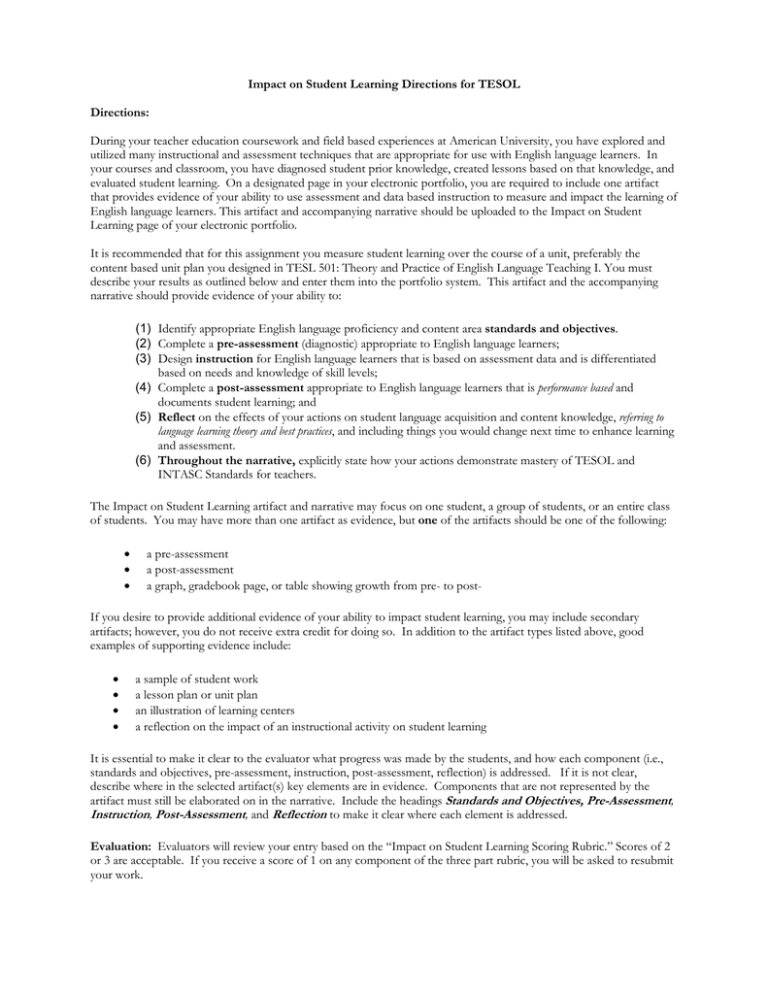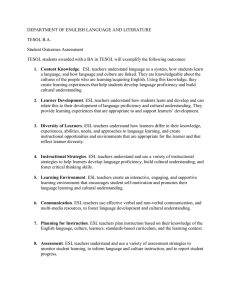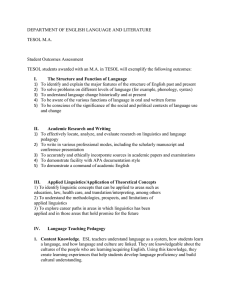Impact on Student Learning Directions for TESOL Directions:
advertisement

Impact on Student Learning Directions for TESOL Directions: During your teacher education coursework and field based experiences at American University, you have explored and utilized many instructional and assessment techniques that are appropriate for use with English language learners. In your courses and classroom, you have diagnosed student prior knowledge, created lessons based on that knowledge, and evaluated student learning. On a designated page in your electronic portfolio, you are required to include one artifact that provides evidence of your ability to use assessment and data based instruction to measure and impact the learning of English language learners. This artifact and accompanying narrative should be uploaded to the Impact on Student Learning page of your electronic portfolio. It is recommended that for this assignment you measure student learning over the course of a unit, preferably the content based unit plan you designed in TESL 501: Theory and Practice of English Language Teaching I. You must describe your results as outlined below and enter them into the portfolio system. This artifact and the accompanying narrative should provide evidence of your ability to: (1) Identify appropriate English language proficiency and content area standards and objectives. (2) Complete a pre-assessment (diagnostic) appropriate to English language learners; (3) Design instruction for English language learners that is based on assessment data and is differentiated based on needs and knowledge of skill levels; (4) Complete a post-assessment appropriate to English language learners that is performance based and documents student learning; and (5) Reflect on the effects of your actions on student language acquisition and content knowledge, referring to language learning theory and best practices, and including things you would change next time to enhance learning and assessment. (6) Throughout the narrative, explicitly state how your actions demonstrate mastery of TESOL and INTASC Standards for teachers. The Impact on Student Learning artifact and narrative may focus on one student, a group of students, or an entire class of students. You may have more than one artifact as evidence, but one of the artifacts should be one of the following: a pre-assessment a post-assessment a graph, gradebook page, or table showing growth from pre- to postIf you desire to provide additional evidence of your ability to impact student learning, you may include secondary artifacts; however, you do not receive extra credit for doing so. In addition to the artifact types listed above, good examples of supporting evidence include: a sample of student work a lesson plan or unit plan an illustration of learning centers a reflection on the impact of an instructional activity on student learning It is essential to make it clear to the evaluator what progress was made by the students, and how each component (i.e., standards and objectives, pre-assessment, instruction, post-assessment, reflection) is addressed. If it is not clear, describe where in the selected artifact(s) key elements are in evidence. Components that are not represented by the artifact must still be elaborated on in the narrative. Include the headings Standards and Objectives, Pre-Assessment, Instruction, Post-Assessment, and Reflection to make it clear where each element is addressed. Evaluation: Evaluators will review your entry based on the “Impact on Student Learning Scoring Rubric.” Scores of 2 or 3 are acceptable. If you receive a score of 1 on any component of the three part rubric, you will be asked to resubmit your work. Impact on Student Learning Scoring Rubric Directions: Use the following rating scale to assess the Impact on Student Learning artifact. Include comments that support your rating and provide constructive feedback to the candidate. Criteria Components English Language Proficiency and Content Standards and Objectives Description of Pre-Assessment Description of Instruction Description of Post-Assessment Reflection One artifact representing the assessment or the assessment results Needs Improvement (1) * must be resubmitted* Meets Standard (2) Exceeds Standard (3) Narrative does not include all elements (i.e., standards and objectives, preassessment, instruction, postassessment, reflection). Assessments and instruction are not described adequately enough to provide understanding of the practices. No artifacts are present or the one required artifact is not of the following o a graph, gradebook page, or table showing growth from pre- to post-assessment o a pre-assessment o a post-assessment English language proficiency and content standards and objectives are appropriate Descriptions of the pre and post assessments of student learning: o provides adequate detail o includes a discussion of assessment results Description of instruction o Provides an overview of how assessment results impacted instructional design o Describes at least one instructional activity in detail There is at least one artifact. That artifact is one of the following: o a graph, gradebook page, or table showing growth from pre- to post-assessment o a pre-assessment o a post-assessment (additional artifacts may be included) Thoughtful reflection on the impact of actions on student learning as it relates to selected language and content objectives. English language proficiency and content standards and objectives are appropriate and complementary Descriptions of the pre and post assessments of student learning: o provide informative detail o include a thorough discussion of assessment results Description of instruction o Provides a clear and detailed explanation of how assessment results impacted instructional design o Describes at least two instructional activities in detail There is at least one artifact. That artifact is one of the following: o a graph, gradebook page, or table showing growth from pre- to post-assessment o a pre-assessment o a post-assessment (additional artifacts may be included) Insightful reflection on the impact of actions on student learning and how changes in instruction and assessment could have influenced the results related to selected language and content objectives. Assessment TESOL Standard 4.b. Language Proficiency Assessment. Candidates know and use a variety of standards-based language proficiency instruments to inform their instruction and understand their uses for identification, placement, and demonstration of language growth of ESOL students. Assessments do not measure language and content objectives Assessments and their discussion do not demonstrate capable understanding of standards based or performance assessment of English language learners. Candidate used standards based and performance assessments that appear to be appropriate for use with English language learners and valid measures of language proficiency and content knowledge objectives Candidate created and used standards based and performance assessments that appear to be exemplary for use with English language learners and valid measures of language proficiency and content knowledge objectives Candidate discussion of assessments and assessment results demonstrates understanding of their usefulness in informing instruction and demonstrating growth in language proficiency and content knowledge. Candidate discussion of assessments and assessment results demonstrates exceptional insight into their usefulness in informing instruction and demonstrating growth in language proficiency and content knowledge. Standard 4c. Classroom – based Assessment for ESL. Candidates know and use a variety of performance-based assessment tools and techniques to inform instruction. Page 2 of 3 Criteria Instruction Standard 3.a. Planning for Standards-Based ESL and Content Instruction Candidates know, understand, and apply concepts, research, and best practices to plan classroom instruction in a supportive learning environment for ESOL students. Candidates serve as effective English language models, as they plan for multilevel classrooms with learners from diverse backgrounds using standards-based ESL and content curriculum. Standard 3.b. Managing and Implementing Standards-Based ESL and Content Instruction Candidates know, manage, and implement a variety of standards-based teaching strategies and techniques for developing and integrating English listening, speaking, reading, and writing, and for accessing the core curriculum. Candidates support ESOL students in accessing the core curriculum as they learn language and academic content together. Reflection 1a Describing Language: Candidates demonstrate understanding of language as a system and demonstrate a high level of competence in helping ESOL students acquire and use English in listening, speaking, reading, and writing for social and academic purposes. Needs Improvement (1) * must be resubmitted* Meets Standard (2) Exceeds Standard (3) Instructional strategies do not appear effective in helping students meet language proficiency and content knowledge objectives. Instructional activities and their discussion do not demonstrate understanding of how to plan, manage, and implement instruction that will enable English language learners to meet language proficiency and content knowledge objectives Instructional activities are not effectively differentiated to meet the needs of diverse learners Candidate used assessment results to plan, manage, and implement instruction that applies concepts, research and best practices in teaching English language learners to enable students to learn academic content and language. Candidate differentiated and scaffolded instruction in standards-based ESL and content curriculum to meet the needs of students of different language proficiency levels and prior knowledge. Candidate incorporated and adapted standards-based materials, resources and technologies to facilitate effective ESL and content teaching. Instructional activities are connected to pre-assessment data Candidate discussion of instruction illustrates - the connection to pre-assessment data - understanding of standards and ESL content based instruction theory, concepts, and best practices Candidate used assessment results to plan, manage, and implement exemplary instruction that applies concepts, research and best practices in teaching English language learners to enable students to learn academic content and language. Candidate differentiated and scaffolded instruction in standards-based ESL and content curriculum to meet the needs of students of different language proficiency levels, backgrounds, prior knowledge, and learning styles. Candidate resourcefully and/or creatively incorporated and adapted standards-based materials, resources and technologies to facilitate effective ESL and content teaching. Instructional activities are clearly connected to preassessment data Candidate discussion of instruction illustrates - a clear connection to pre-assessment data - exemplary understanding of standards and ESL content based instruction theory, concepts, and best practices Assessments, instruction and discussion demonstrate little understanding of language as a system, research and current practice in ESL teaching, or competence in applying this knowledge to help English language learners acquire and use English for social and academic purposes. Assessments, instruction and discussion demonstrate an understanding of language as a system, research and current practice in ESL teaching, and competence in applying this knowledge to help English language learners acquire and use English for social and academic purposes. Assessments, instruction and discussion demonstrate exceptional understanding of language as a system, research and current practice in ESL teaching, and competence in applying this knowledge to help English language learners acquire and use English for social and academic purposes. Page 3 of 3





